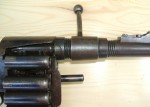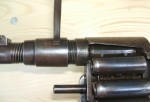The Treeby chain gun was a .54 caliber percussion rifle that could fire 14 rounds in rapid succession. Designed in 1854, it was unlike anything else available at the time. Only two were ever made, with the hope of receiving a contract from the British Army. The gun was tested and found wanting, and no further production was ever undertaken.

Firing the Treeby rifle requires following a specific process. First, of course, each of the 14 chambers must be loaded with powder and ball, and a percussion cap placed on the firing nipple on each one. Once the weapon is all loaded, the lever on the barrel must be rotated up. The barrel is connected to the frame by way of a very coarse thread, so lifting the barrel lever pulls the barrel forward, away from the chamber. Next, the hammer is manually cocked, which rotates the chain of chambers and indexes one into position. Then the barrel lever is rotated back down, pulling the barrel in and sealing it against the chamber. Only now can the trigger be pulled, which fires the round currently sealed up to the barrel.

After firing, the process repeats until all 14 rounds are expended. It is very important to lock the barrel onto the chamber BEFORE firing, and forgetting this critical step in the heat of battle could happen pretty easily, with unfortunate consequences. The manual of arms for this rifle is likely one of the reasons is was not pursued by the British Army. It also lacks any sort of usable front grip or stock, although this could have been addressed with further development.

Despite its somewhat complex nature, the moving barrel offers several significant benefits. First, by sealing the chamber for each shot it provides higher velocities than revolver-type designs with a gap between barrel and cylinder. The Treeby also would be very unlikely to suffer from chain-firing, in which the spark from the main chamber ignites one or more adjacent chambers (which can be a problem in percussion revolvers when they are not loaded carefully and properly). Since the chamber is fully sealed, no sparks or blast can escape in the vicinity of the open chambers.
One Treeby (which we have photos and video of) is in a private collection, and the other resides at a museum in Hampshire, UK.
Videos
Photos
You can download the complete gallery in high resolution here.























So this is where all those “chain shotguns” seen in video games come from! That’s one odd rifle…
Now, if I had a private army or someting like that at the time this mechanical piece of art was created, I would equip my troops with this thing. Though there may be modifications, sutch as chaingeibe chains, bayonet mounts and so on. Thanks Ian for showing us this!
I’d simply have a more conventional rifle, without the chain mechanism, and instead have soldiers carry the chambers in belt-pouches. which to some defeats the point of a “chaingun”, but seeing as it’s the 1850’s, and napoleonic tactics are basically still the doctrine of the day, (with all the misfires and confusion that come with it).
That is one of the coolest things I have ever seen. What a fascinating design!
Ian, I really enjoyed the video, and am a fan of ForgottenWeapons.com!
There is at least a 3rd Treeby in existence. We have one that is currently on loan to the NRA Museums. Our specimen is much rougher than the one in your video with pitting on nearly all surfaces.
Ours has an interesting additional feature – a folding vertical metal fore-grip. This is the earliest gun to have one of these that I’ve seen.
Ours also lacks the protruding forward underneath the barrel that is shown on the sample in the video.
Jim
Rather than call it a chaingun (wherein a driven chain operates the entire firing cycle), I’d call it a fixed-belt-fed rifle.
Looking at it, it wouldn’t be hard at all to imagine a modest redesign which re-positions the belt-drive sprocket to permit the use of a non-closed-loop belt of chambers.
Does anyone know anything about the ammunition and the chain? I know the chain was made up of percussion rounds that acted as links in the chain. Any info on how much powder was used per round? Lastly, did the gun have to be taken apart to put in a new chain, or was the new (loaded) chain fed through the mechanism and reconnected to the other end after words?
As noted someone just loads the chambers without taking out the chain. This would have required a loader or two and a gunner plus about a dozen guns in an emplacment. A team that was trained could put out hundreds of rounds in a very short period of time. Basically a proto machine gun rate of fire.
The chain was loaded while still in the rifle.
For transport, the caps would have been taken off.
About that, in battle, I could not see the caps staying on very well if the rifle was being moved around and knocked a lot, probably could be fixed by adding a plate behind the chain/belt.
Back in the 1950’s I had one of these Treeby rifles. An Uncle and I shared a common interest in collecting firearms. Unusual ones were of particular interest. During the time we owned the piece we were given to understand that there was a similar example in the Tower of London collection. Unfortunately I never did get an opportunity to view that one before leaving the UK in 1965.
Our example was complete as the one shown in the photos on this site . However the finish was not as pristine. The engraving was good and well defined. There were areas where the original charcoal blue was still evident particularly around the action frame but on the whole the piece had a fine brown patina. The bore was very good. The mechanical condition was good but the original firing pin (striker) was missing. I made a replacement one of these.
During an apprenticeship to the Gunmaking firm of James Purdey and Sons Ltd. I was approached by a Firearm collector / dealer who had been told of the Treeby. At the time my Uncle was under some financial pressure. Unfortunately this was a deciding factor and this interesting piece was sold . I heard some time later that the Treeby had been sold in America. However I never confirmed this.
I think that your example shown , as was ours, were made as commercial firearms. The standard of presentation is well above what would have been done to a piece made up specifically for Military Ordinance trials. The firearm would have had some interest for the well heeled Victorian Gentleman/tinkered. I feel there are probably one or two more yet to surface
does anyone know where I can find a cad model of a gerandoni air rifle
Please make a Forgotten Weapons Instagram!!! I will follow!
It may be of no interest but the inventor, M Treeby, is an ancestor of mine, Georgiana Gibson, the 11th child of a John Gibson, rector of Holybourne, in east Hampshire..Marcus Gibson, London.
He was an ancester of mine also. Thomas Wright Treeby from Devon in England was my Great-Uncle, the brother of a William Treeby who came to New Zealand chasing Gold around 1855.
If you would like to correspond here is my email address
Graeme.treeby@gmail.com
Definitely extremely interesting gun! Thank you so much for providing such in debth details and pictures! With the help of these refferences images I was able to make a small project of my own and 3D make the gun model!
This same rifle is currently up for auction during the August 25th 2023 RIA auction. Would love to own this thing!